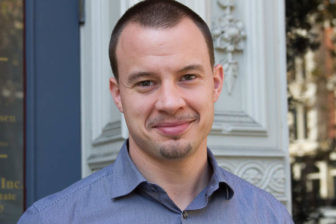California has comprehensively strengthened its gun safety laws over the past 25 years and is now generally considered to have the strongest gun safety laws in the nation. Giffords Law Center, which evaluates the strength of state gun laws, affords California the top rank on its Annual Gun Law Scorecard. These legislative changes have been associated with significant declines in overall gun deaths and homicides at the state level.

Vaughn Crandall
Despite this progress, in 2018 the state still experienced over 1,400 gun homicides and 4,200 nonfatal shootings. In California and nationally, gun homicides remain the leading cause of death for African-American males between the ages of 15 and 34 and the second-leading cause for Latino males in that age bracket.
While gun violence has a disproportionate impact on people of color, all California residents bear the costs. The Giffords Law Center estimates that Californians pay approximately $6.5 billion per year in direct costs associated with gun violence, including the costs of medical care, lost wages, costs to employers and the costs of criminal justice agencies. Meanwhile, over 50% of all gun violence in California occurs in just 24 cities.
Solutions working in California’s most challenging cities
Urban gun violence is not an intractable problem. Over the last 25 years, cities across the country have tested strategies to reduce shootings and homicides. The strongest evidence supports an approach often called “Operation Ceasefire” or “focused deterrence.” This strategy creates a police-community partnership that intervenes within networks of young men at imminent risk of violence — those most likely to shoot someone or be shot themselves.
From 2012 to 2017, the California Partnership for Safe Communities partnered with the cities of Oakland and Stockton to design and implement Ceasefire strategies. A recent impact evaluation by Northeastern University found that Oakland experienced a 52% reduction in fatal and nonfatal shootings between 2011 and 2017 that was primarily driven by the implementation of the Oakland Ceasefire strategy. The evaluation also found reductions in gun shot victimization and reduced rates of arrest among program participants.
The strategy also helped dramatically reshape Oakland Police Department’s approach to policing: Oakland police made 60% fewer arrests in 2017 than in 2009, while the rate of solved homicides grew from 29% to over 80% (as of 2018). Stockton, meanwhile, also reduced total shootings by more than 50% between 2012 and 2018.
Similarly, through the development of a partnership-based approach, the Urban Peace Institute, the Los Angeles Mayor’s Office of Gang Reduction and Youth Development, the Los Angeles Police Department and a range of intervention partner organizations have reduced gun violence by 70% in Los Angeles over the last 15 years. This includes innovative approaches to handle shootings scenes, the professional certification of outreach workers, a sophisticated management infrastructure within the Mayor’s Office and robust community-police partnerships in Watts and elsewhere that have helped reduce both serious violence and levels of arrest while increasing residents’ trust and confidence in the police.
Meanwhile, the city of Richmond’s Office of Neighborhood Safety (ONS) developed a cutting-edge outreach and intervention model anchored in the Peacemaker Fellowship that focuses intensive engagement and long-term support on the small number of young men involved in the vast majority of shootings in Richmond. Since the launch of ONS, gun violence has also been reduced in Richmond by over 66%, and a recent impact evaluation cites ONS as a critical factor in these reductions.
Citing these reductions, and as a result of ongoing advocacy from a coalition of over 50 community-based organizations, California recently increased funding for local violence reduction efforts through the California Violence Intervention Grant Program from $9 million a year to $30 million a year. This significant investment follows the lead of states like Massachusetts, New York and Connecticut, which have all invested significant public dollars in supporting violence intervention strategies in cities most impacted by violence. All three states have experienced reductions in violence at the state level and have generated significant cost savings.
Connection between violence reduction, reducing incarceration
California has led the nationwide charge to decrease mass incarceration through the passage of major public policy initiatives, including Public Safety Realignment and propositions 47 and 57. Since 2011, these policies resulted in the release of 40,000 people from state prisons (though some were transferred to local jails) and made a series of progressive changes to sentencing and community supervision policy.
According to the Vera Institute, California’s policy changes alone are responsible for 40% of the national decline in prison populations. Unfortunately, efforts to undo these reforms are already under way because of the inaccurate perception among the public and some law enforcement leaders that they have resulted in increases in serious crime. The success of these policy efforts will be judged by both reductions in incarceration and crime rates, particularly violent crime.
Two essential but overlooked components of achieving these twin policy goals are local police reform and quality violence intervention programs. While changes in prosecutorial practice and sentencing laws are important, no one can be prosecuted or sentenced without first being arrested by the police. Area-based, aggressive policing strategies tend to sweep large numbers of men of color who aren’t involved in serious crime into the justice system with little public safety benefit, often undermining citizen trust.
Policing strategies that focus on serious violence, leverage an array of community and intervention partners and that seek to minimize arrest are both more effective and receive greater community support. Similarly, effective violence intervention programs can mediate violent conflicts, reduce retaliation and help young men involved in violence move toward lower-risk lifestyles and positive opportunities.
Changing policing strategies and investing in violence intervention are essential to achieving maximum safety with minimum incarceration. This is essentially local work — policing and intervention operate on the neighborhood and city level. Yet, this work that can be supported — even galvanized — by state dollars, and by state-funded technical assistance and research support.
Like New York, Massachusetts and Connecticut, California is taking action to address the interconnected challenges of violence, police-community distrust and overincarceration. California's ability to sustainably reduce prison populations depends on a critical mass of cities demonstrating that they can improve public safety while reducing incarceration.
The state’s large increase in CALVIP funding for local violence reduction efforts is a critical step in the right direction. Now, city and community leaders must come together to ensure those funds are well used to actually reduce violence and incarceration in their own communities. The future of state and national efforts to reduce gun violence and incarceration hangs in the balance.
Vaughn Crandall is the co-director of the California Partnership for Safe Communities. He has led and supported violence reduction and justice reform efforts in numerous U.S. cities and has consulted internationally.

Pingback: California Gets #1 Rating in Gun Safety Laws | The Crime Report
Anyone interested in reducing violence, including gun, domestic, and workplace, should watch One Punch Homicide. It’s getting great reviews and can be seen free online.